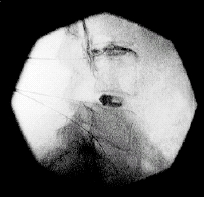Having a Discogram
Having a Discogram
A discogram is a test in which contrast dye is injected into a disk in the spine. Contrast dye is a type of fluid that shows up on X-ray. This lets a radiologist see if the disk is normal or not. The test may reproduce your back or leg pain. This helps your healthcare provider find which disk is causing your symptoms. The test is often done when certain treatments for pain, such as surgery, are being considered. As part of the test, an image of the disk is taken. This image shows where and how the disk is damaged.
Risks and possible complications
Every procedure has risks. Your healthcare provider will discuss them with you. Some possible risks of a discogram include:
Bleeding
Infection
Nerve damage
Getting ready for your discogram
For your safety and the success of your test, tell your healthcare provider if you:
Are pregnant or think you may be pregnant
Have any bleeding problems
Take blood thinners (anticoagulants) or other medicines, including aspirin, herbs, or vitamin supplements
Have any allergies
Have recently been sick or have any chronic conditions
Prepare for your test as instructed. Be sure that you:
Stop taking medicines, herbs, and supplements before the test as advised by your healthcare provider.
Follow any directions you’re given for not eating or drinking before the test.
Arrange for someone to drive you home after the test.
The day of your discogram
Allow plenty of time before your appointment to check in. You will need to sign a form stating that the test has been explained to you. If you have questions, ask them before you sign the form. Your visit may last several hours.
During the test, you will lie on your stomach or your side on an exam table. You may be given medicine through an IV to help you relax. The healthcare provider cleans your lower back and covers the area with sterile drapes. The area is numbed with medicine. He or she places a needle into each disk that is being tested. Then the provider injects a contrast solution into one or more of the disks in your spine. A picture of the disk is taken. The healthcare provider may test more than one of your disks. This is so the results of the two tests can be compared and help to find the source of your pain.
An injection into a disk does cause pain. But keep in mind that this will help your healthcare provider diagnose you. He or she will ask how your pain feels, and if it’s like the pain you felt before. The pain may be worse than your usual back pain. Make sure to tell your healthcare provider how you feel.
You may be given pain medicine after the discogram. You may also have a CT scan. This imaging test gives more information about the disk. Your healthcare provider will tell you when you can get the results of your test.
A discogram may be painful. But it can give your healthcare provider vital information to help plan your treatment.
After your discogram
Have an adult friend or family member drive you home after the test.
Drink plenty of water to help flush the contrast fluid from your body.
Take it easy for the rest of the day, as advised.
Lie down with your head flat if you get a headache.
You may be in more pain than usual for up to 5 days after the discogram. Your healthcare provider may recommend medicine to help ease the pain. If the increased pain lasts longer than 5 days, tell your healthcare provider.
When to call the healthcare provider
Call your healthcare provider right away if you have:
Worsening pain in your back or legs
Fever of 100.4°F (38°C) or higher, or as directed by your healthcare provider
Numbness, tingling, or weakness in your legs
A headache that lasts for 2 days or more
Updated:
March 21, 2017
Sources:
Diagnostic testing for low back pain. UptoDate.
Reviewed By:
Bass, Pat F III, MD, MPH,Fetterman, Anne, RN, BSN,Image reviewed by StayWell medical illustration team.,Trevino, Heather M, BSN, RNC
